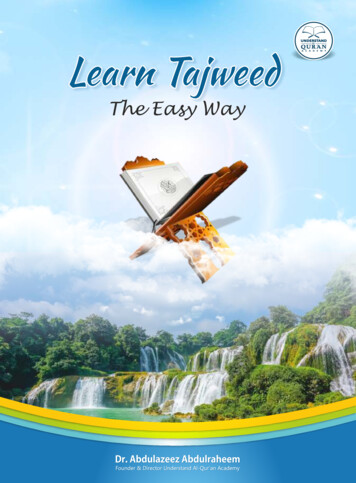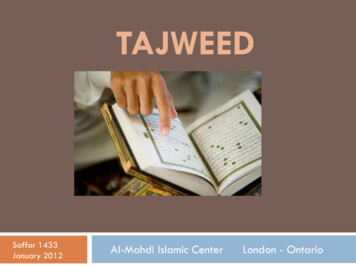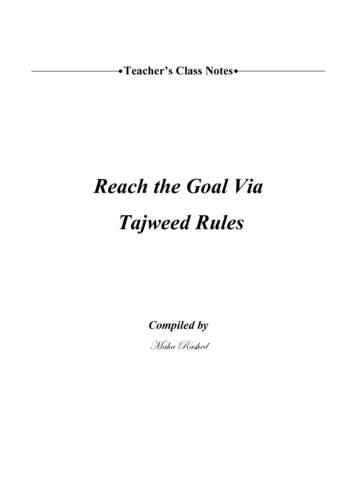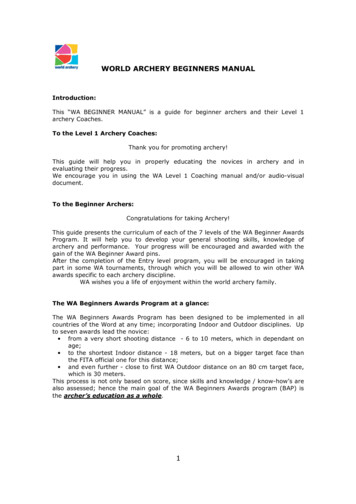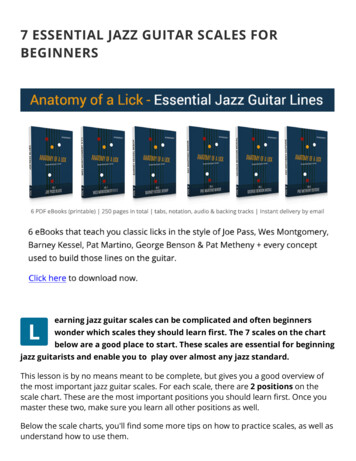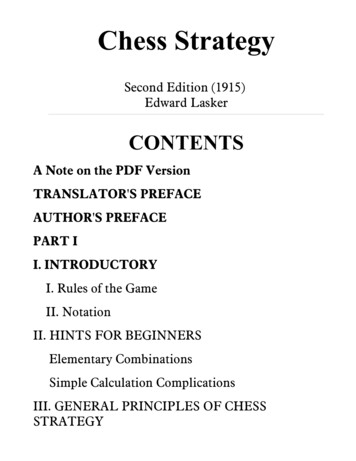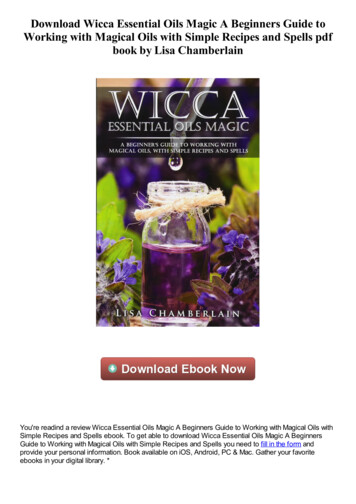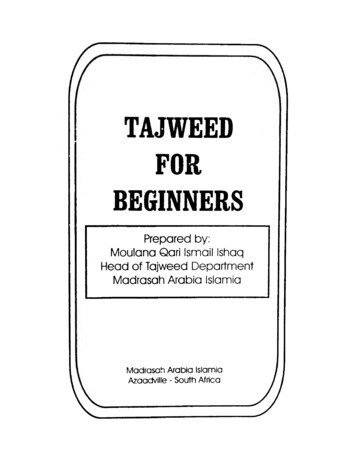
Transcription
TAJWEEDFORBEGINNERSPrepared by:Moulana QariHeadIsmail Ishaqof TajweedDepartmentMadrasah ArabiaMadrasah ArabiaAzaadville-IslamiaIslamiaSouth Africa
btr; mm\\fflKJ T yr\.-*i- Ulj- LJ - .uiJlTAJWEEDFORBEGINNERS
.TAJWEED FOR BEGINNERSTABLE OF finition, Purpose and Benefit of Tajweed1Major, Minor errors2Rules of Isti'aazhah and Bismillah4The Arabic alphabet*8Makhaari j9The Teeth11Sifaat16Sifaat - Mutadhaaddah17Sifaat - Ghair Mutadhaaddah22Terms to know24Sifaat-e-Aaridhah25Rules of Alif27Rules of Laam28Rules of Raa29Rules of Meem and Noon Mushshaddad34Rules of Meem Saakin34Rules of Noon Saakin nd TanWeen36Rules of Madd40Madd-e-AsliY.Y.V.V."//."."/. Y40Madd-e-Far'ie. .41Madd-e-Muttasil. .41Madd-e-Munfasil. ./////. .42Madd-e-Aaridh Waqf iY . YY Y 42;.!i.5.5.7.3.).).!Madd-e-LaazimY Y Y Y [43Rules of WaqfY. YYYYY.Y YY YY .46Waqf according to Last LetterY . 46Waqf according to Place/././ 4SWaqf according to Condition of Qari.Y 50Saktahc,Miscellanea!!!!!!!!!52*!.
THE IMPORTANCE OF TAJWEEDAllah Taala states"AndintheQuran Majeed:Quran with measure."In the commentary of this verse, Hazrat Ali RA.states: *Tar,teel means to know the Tajweed of theletters and to recognize the places of pausing."recite theanother place, Allah Ta'ala says:"And with measure have We revealedIn a Hadlth it has been narrated:Init(the Quran).'Quran be recited In the mannerwas revealed" Since the Quran was revealed'with Tajweed, it Is compulsory to recite the Quranwith Tajweed. We also know that Allah Taala hasmade it compulsory upon us to learn Tajweed because without the knowledge of Tajweed, wewill not be able t recite the Quran with Tajweedwe do not do so, then we are liable to be sinfulespecially those that do not care, for it is narrated"Allah desires that theitIfare they who recite the Quran, while theQuran curses them.thatmany
TAJWEEDTAJWEED MEANS: To recite every letter CORRECTLY,from it's Makhraj, with all it's Qualities.THE PURPOSE OF TAJWEED t To recite the QURAAN in themanner IT was revealed to, AND recited by NABI-EKAREEM SALLALLAHU ALAIHI WA SALLAM.THE BENEFIT OF LEARNING AND RECITING THE QURAAN,WITH TAJWEED is that a person will be honoured inthis world (DUNYA) and the Hereafter (AAKHIRAT).NOTE: It is COMPULSORY (FARDH) to learn TAJWEED.Questionsl.What is the definition of Tajweed?2. What is the purpose and benefit of Tajweed?3. What is the Law (rule) concerning Tajweed?
.ERRORSErrors which are made whilst reciting the QURAAN areof TWO TYPES:1.MAJOR ERRORS.V- i2.MINOR ERRORS.M1.1.instead of reciting xJL \ a person recitesj Jijjor instead ofor in place ofJ* oj*and so on.To add a letter to a wordand a Safter after the; thus recitingin -uLijt J'jlL JITo delete a letter from a worde.g. not to recite theand thus recite it as4a person reciteshe recitese.g. a person adds a J3'MAJOR ERRORS:To recite one letter in place of another;e.g.2.""J3in \JjJ JaLSJ JTo recite one HARKAT in place of anothere.g.to recite with a KASRA (ZER) on the U l ininstead of a FAT 'HA (ZABAR)or to recite the HAMZAH ininstead of KASRA. jj» \with a FAT 'HA
I5.To recite a HARKAT in place of a JAZMe.g To read on both the Jthusand/orfwith a ZABARoJv tNOTE: To make any of the above mentioned errors isa MAJOR SIN AND HARAAM. It is COMPULSORY TO REFRAINFROM THESE ERRORS.******************MINOR ERRORS2.Those errors (mistakes) a person makes, when he doesnot recite with any of those RULES which show theBEAUTY OF THE QURAAN-E-KAREEMe.g. not to recite thejino Cowith a fullmouth when it has a FAT 'HA, or not to recite theTWOaJin*J \with a full mouth when there isFAT 'HA or a DHAMMAH (PESH) before them,or not to make GHUNNA,IKHFAA or MADD.NOTE: To make any of these Minor Errors is a MINORSIN AND MAKROOH. To refrain from these Errors isalso NECESSARY,Questionsl.Give the names of the two types of -errors?2. Name any three Major Errors?3. What is the Law (rule) concerning Major andMinor Errors?4. What are Minor Errors?
.b ijL ITHE RULES OF ISTl'AAZHAHAND BISMILLAHBefore reciting the QURAAN-E-KAREEM, it is NECESSARYto recite ISTI'AAZHAH.A jJtWhen STARTING arecite BISMILLAHSURAH,tjbliJI (#*willitbeail % \NECESSARYtoBUT NOT AT THE BEGINNING OF SURAH TAUBAH (PARA 10)If commencing anywhere in a SURAH , besides thebeginning, then it will be OPTIONAL to reciteBISMILLAH, but it will be BETTER IF RECITED.Whilst reciting the QURAAN-E-KAREEM, if a personspeaks of worldly affairs, OR replies to someone'sSALAAM, OR has something to eat or drink, then itwill be NECESSARY for him to REPEAT THE ISTI'AAZHAHBEFORE CONTINUING.A. THE RECITATION OF ISTI'AAZHAH AND BISMILLAHTHE BEGINNING OF AATSURAH.This can be done in FOUR ways:1.WASLE KUL.2.WASLE AWWAL-FASLE THAN I3.FASLE AWWAL-WASLE THAN I4.FASLE KUL.fy/j .NOTE: WASL means: To recite TOGETHER.FASL means: To recite SEPARATELY.tydfltftysd/tfidsk}?'}fyf
.Therefore;1. WASLE KUL means to recite ALL together.WASLE AWWAL - FASLE THANI means to recite the2.FIRST TWO together and the THIRD separately.FASLE AWWAL - WASLE THANI means to recite the3FIRST separately and join the SECOND AND THIRD.4. FASLE KUL means to recite ALL separately.WASLE KUL: To recite ISTI'AAZHAH AND BISMILLAHand the beginning of the SURAH together1.e.g. r S j i J \ tjKllI 6* Mi #WASLE AWWAL - FASLE THANI t To recite ISTI'AAZHAHAND BISMILLAH together, stopping after BISMILLAHand reciting the beginning of the Surah separately2.FASLE AWWAL - WASLE THANI: To recite ISTI'AAZHAHseparately and BISMILLAH and the beginning of theSurah together3.4.FASLE KUL: To recite ISTI'AAZHAH, BISMILLAH andthe beginning of the Surah separatelye g''% &i&&i*jsr--\o.-i-r3»»tjM,«t yi
THB RECITING OF ISTI'AAZHAH, BISMILLAH ANDANYWHERE IN BETWEEN A SURAH, BESIDES THEBEGINNING COULD BE DONE IN FOUR WATS.NOTE: Only TWO ways are permissible, i.e. FASLE KULand WASLE AWWAL - FASLE THAN IThe remaining TWOways are NOT permissible.B.FASLE KULx To recite ISTI'AAZHAH, BISMILLAH andthe AAYAT all separately. To recite in this way ispermissible1.e.g.% & &j O c ' i lWASLE AWWAL - FASLE THANI: To recite ISTI'AAZHAHand BISMILLAH together and the AAYAT SEPARATELY. Torecite in this way is permissible2.FASLE AWWAL - WASLE THANI: To recite ISTI'AAZHAHseparately, and BISMILLAH and the AAYAT together. Torecite in this way is NOT permissible3.WASLE KULi To recite ISTI'AAZHAH, BISMILLAH andthe AAYAT together. To recite in this way is NOTpermissible4.e.g.ji- *&&*rJl .sk fc ' sA I
C.THE COMPLETING OF A SURAH AND THE BEGINNING OFTHE NEXT SURAH COULD BE DONE IN FOUR WAYS.WASLE KUL: To recite the END of a SURAH,BISMILLAH and the BEGINNING of the NEXT SURAH all1.together.e.g2. WASLE AWWAL - FASLE THANIia SURAH and BISMILLAH togetherTo recite the END ofand the beginning ofthe NEXT SURAH separatelyNOTE: To recite in this manner is NOT permissible,as a person may think that BISMILLAH is part of thePREVIOUS SURAH, whereas the place of BISMILLAH is atthe beginning of the SURAH, not the end.FASLE AWWAL - WASLE THANI: To recite THE END ofSURAH separately, and BISMILLAH and the BEGINNINGof the NEXT SURAH together3.aFASLE KULt To recite the END of a SURAH,BISMILLAH and the BEGINNING of the NEXTseparately4.SURAH
Questionsl.What does the terms Isti'aazhah and Bismillahmean?2. When should Isti'aazhah be read?3. When will Bismillah be read?4 .When will it be necessary to repeat theIsti 'aazhah?5. What does Wasl and Fasl mean?6. When starting a surat, in how many ways couldIsti'aazhah, Bismillah and the beginning of thesurat be read?7. Will it be permissable to recite Wasle AwwalFasle Thani when completing one surah andbeginning the next? Give the reason also.Hadhrat UthmanRA narratesthatRasulullah (Sallallahu-Alayhi-Wasallam) said:"The best amongst you is he who learnsthe Quran and teaches it."If there was no Hadith except this Hadithsufficient to prove theit would have beenimportance and virtue of the HolyQuran.\
THE ARABIC ALPHABET ARE 29 WHICH ARE AS FOLLOWS:*U,JEEMVijjRAAt-iTAATHAABAAALIFt tp 'DAAL2HAALttHAAKHAA0*0*0-0DHAAD SAADGHA1NNOON MEEM'JZAASHEEN SEENto K. *tFAAi;AINLAAM*];4ZHAATAAKAAFQAAFuy %5M {J\&9YAA HAMZAH HAA8WAAW
.MAKHAARIJtfakhrajis the place where the sound of the letteroriginatesAccording to Imaam Khalil Rahmatullahi-alaih thereare 17 MAKHAARIJ,1.JOWFE-FAMp yrEmptiness of the mouth.From this Makhraj is pronounced the three letters ofMADD,e.g.fjJ\{# They are known as HUROOFE-MADDAHJ)Sand HUROOFE-HAWA-IEYAH2.AQSA-E-HALQ{j*[}PJ .ujJ*- *S'The part of the throat nearest to the chest.From this Makhraj is pronounced the letters p3.WASTE-HALQand q(jf The centre of the throat.From this Makhraj is pronounced the letters4.ADNAA-E-HALQ and J* J The part of the throat nearest to the mouth.From this Makhraj is pronounced theletters and
NOTE: The above lettersC C are known as HUROOFE-HALQI* ] fas they originate from the throat.THE EXTREME BACK OF THE TONGUE WHEN TOUCHING THEPALATE.5.From this Makhraj the letter( is pronounced.6. THE BACK OF THE TONGUE, (BUT NOT AS FAR BACK ASTHAT OF QAAF, A LITTLE TO THE FRONT OF THE MOUTH),WHEN TOUCHING THE PALATE.From this Makhraj the letter jNOTE: The lettersLAHATIYAHZ?pand J /// is pronounced.are known as HUROOFE-and HUROOFE-LAHWIYAH becausethey are pronounced from near the LAHAAT lj Uvula»THEPALATE.7.CENTREOFTHETONGUE WHEN TOUCHING THEFrom this Makhraj is pronounced the letters j»(S GHAIR MADDAH.NOTE: The letters .J*as HUROOFE-SHAJRIYAHJ" L GHAIR MADDAH are known*!**?because they arepronounced from the centre of the mouth.10
THE TEETH.A person commonly has 32 teeth. They are as follows:THANAYA:IV --""':V? K-Upper Central Incisors. C -Lower Central Incisors.Two THANAYA ULYATwo THANAYA SUFLACentral Incisors (4)NEXT TO THE THANAYA ON EACH SIDE ARE THERABA'IE:y \j-Upper Lateral Incisors.SUFLA \j-Lower Lateral Incisors.Two RABA'IE ULYATwo RABA'IELateral Incisors (4)-fyjNEXT TO THE RABA'IE ON EACH SIDE ARE THEANYAAB:—'&Two ANYAAB-E-ULYA-Canines (4)&f * t'Two ANYAAB- E-SUFLA J - t'- Upper Canines.-Lower Canines.NEXT TO THE ANYAAB ON EACH SIDE ARE THEDHAWAAHIEK: U?/j -First Premolars (4)Two DHAWAAHIEK-E-ULYAOfJ f-Upper first PremolarsTwo DHAWAAHIEK-E-SUFLAJ -r*! -Lower first Premolars11
NEXT TO THE DHAWAAHIEK ON EACH SIDE ARE THETAWAHIEN:J * -Second Premolars (4), FirstMolars (4), Second Molars (4)V? tfJ?Six TAWAHIEN-E-ULYA-Upper Second Premolars, First and Second Molars.Six TAWAHIEN-E-SUFLA -yJ*f{Lower Second Premolars, First and Second Molars.The last tooth in the mouth on each side is calledthe NAAJIZ(third molar).' l*Two Nawaajiz UlyaTwo Nawaajiz Suflal *'yon left and right.!jf' f'yon left and right.NOTE: The DHAWAHIEK, TAWAHIEN, NAWAJIEZ, togetherare known as the ADHRAAS.They are the premolars which are (8):2 Top right2 Top left2 Bottom right2 Bottom leftand the molars which are (12)3 Top right3Top left3 Bottom right3 Bottom left.THE TEETHTHE TEETH COMPLETE ARE 30 AND 2THANAYA ARE 4 AND RABA' IE ARE 2,2ANYAAB ARE 4 AND THEN 20 REMAINADRAAS HAVE THE QARIS GIVEN IT'S NAMEDAWAHIEK 4 AND TAWAHIEN 12 YOU KNOWNAWAJIEZ SIDE BY SIDE HAS 2, 2 ALSO.12
Central IncisorsLateral IncisorsCaninesPremolarsMolars—Centre of TonoueImmediate Top of TongueTin ofTongueInner Centre of-tftLW'BottomLfc
THE BACK EDGE OF THE TONGUE, UPTURNED, WHENTOUCHING THE ROOTS OF THE MOLARS AND THE PRE-MOLARSft.From this Makhraj the letter j*is pronounced.There are three ways of pronouncing the Jfi1. From the right side2. From the left side3. From both sides at the sametimeBut it is commonly easier to pronounce the J?the left side.NOTE: The letterJe is known as:fromHARFE-HAFIYAH Uj because it is pronounced from the upturned sides ofthe tongueTHE EDGE OF THE TONGUE, WHEN TOUCHING THE GUMS OFTHE TEETH, WHICH EXTENDS FROM THE PRB-MOLAR ON ONESIDE, TO THE PRB-MOLAR ON THE OTHER SIDE.9.From this Makhraj the letterJis pronounced.THE EDGE OF THE TONGUE, WHEN TOUCHING THE GUMSOF THE TEETH, WHICH EXTENDS FROM THE CANINE ON ONESIDE, TO THE CANINE ON THE OTHER SIDE10.From this Makhraj the letter11.Ois pronounced.THE EDGE OF THE TONGUE, INCLUDING THE IMMEDIATETOP, WHEN TOUCHING THE GUMS OF THE CENTRAL INCISORS(THANAYA ULYA) AND THE LATERAL INCISORS (RABA'IEYAH)From this Makhraj the letterNOTE: The lettersTARFIYA'J L XyJjJJis pronounced.are known as HUROOFE-AND HUROOFE-ZHALKIYA Z jbecause they are pronouncedtongue.13J &from the edge ofthe
,12. THE TIPOF THE TONGUE WHEN TOUCHING THE ROOTS OPTHE THANAYA ULYA.From this Makhraj the lettersNOTE: The letters-NIET'IEYAH k J,O t/S 2 O arepronouncedare known as HUROOFEbecause they are pronouncedfrom the cavity of the roots of the THANAYA ULYATHE TIP OF THE TONGUE WHEN TOUCHING THE EDGE OFTHE CENTRAL INCISORS (THANAYA ULYA)13.From this Makhraj the letters NOTE: The lettersHUROOFE-LIETHWIYAHj Jj are pronouncedare known as %%because they arepronounced from the teeth which are attached to thegums which in turn are known as LITH-THA.&THE TIP OF THE TONGUE WHEN TOUCHING THE EDGE OF(THANAYA SUFLA)INCISORSLOWER CENTRALTHEINCLUDING THE UPPER CENTRAL INCISORS (THANAYA ULYA)14.From this Makhraj the letters jP {jT J are pronouncedNOTE: The letters j HUROOFE-ASALIYA /l/"Jare known as 2*j?because they arepronounced from the sharp tip of the tongue.THE INNER CENTRE OF THE BOTTOM LIP WHEN TOUCHINGTHE EDGE OF THE UPPER CENTRAL INCISORS (THANAYA15.ULYA)From this Makhraj the letter.14 is pronounced.
16.BOTH THE LIPS (WHEN MEETING)From this Makhraj theare pronounced.NOTE:1. letters ( JGHAIR MADDAHportions ofis pronounced from the wetthe lips.ofis pronounced from the dry portionsthe lips.is pronounced by the incomplete meetingof the lips.fJ2.The letters J»HUROOFE-SHAFAWIYAH*-r *j *jV7f}are known asbecause they arepronounced from the lips.17.KHAISHOOM-?j?THE NOSTRILS.From this Makhraj the GHUNNA is Define Makhraj.2. How many Makharij are there?3. a. What is the Makhraj of J i5 ghair maddah?b. Explain S ghair maddah.4. Recite the poem regarding the teeth.5. a. Which letter is known as Harfe Hafiyah?b.And what is it's Makhraj?c.How many ways are there of pronouncing thisletter?6. Which letters are known as Huroofe Niet'ieyah?7. a. What is the Makhraj of the Huroofe Shafawiyah?b. Describe the difference in the Makhraj of1. 315
KhaishoomJowf
tSIFAATDEFINITION The qualities with which a letter ispronounced is called SIFATSIFAAT ARE OF TWO TYPES s1.LAAZIMAH2.AARIDHAH\ jjfi [fLAAZIMAH t That quality which isletter itself.2. AARIDHAH t That quality which iscircumstances.1.found in thefound duetoLAAZIMAH IS OF TWO TYPES »1.ZHAATIYAH2.MAHALLIYAH1.ZHAATIYAH l5*That quality which has to do with the pronouncing ofthe letter itself. Without the quality,it isimpossible to pronounce the letter. If- the letter ispronounced, it will be incomplete.2.MAHALLIYAH IThat quality which describes the MAKHRAJ ofletter.16the
ZHAATIYAH IS OP TWO TYPES JA,MUTADHAADDAHB.GHAIR MUTADHAADDAHA.MDTADHAADDAHsThose two qualities which are opposite to eachother.NOTE: MUTADHAADDAH has five pairs. From each pair,NEITHER can the two qualities be found together inany one letter, NOR can any letter be without anyone of the two qualities. From each pair, onequality will DEFINITELY be found in a letter.GHAIR MUTADHAADDAHs Those qualities which have NOOPPOSITES.B.A. THEREARE TEN TYPES OF MUTADHAADDAHs -f (1st pair)2.JAHR l5(2nd pair)4.RIKHWAT6.ISTIFAALJlXli» 8.INFITAAH hil]ISMAAT J1.HAMS3.SHIEDDAT5.ISTIE'LA&u (3rd7.ITBAAQ Lt 9.IZHLAAQb A'- "Vpair)(4th pair)(5th P air)10' 4*OJ Jwhich whenis that quality(ftHAMSpronounced, the VOICE of the letter ends off so LOWin the Makhraj, that the BREATH will REMAIN FLOWING.1.,ine.g. TheJ jNOTE:There are 10 LETTERS of HAMS, which are;1. t* j,'jy *o*f/17
2.The LETTERS of HAMS are known as MAHMOOSAH.3.The OPPOSITE of HAMS is JAHR.which whenis that quality,JAHRjf*endsoff so HIGHpronounced, the VOICE of the letterin the Makhraj, that THE BREATH will not continue to2.flow.e.g.The*ingreNOTE: 1. The LETTERS of JAHR are known asMAJ HOORAH'.0j%2. Besides the LETTERS of MAHMOOSAH, the restare MAJ 'HOORAH. *Xs,is' that quality, which whenSHIEDDATpronounced the VOICE of the letter will be HARD, andthe VOICE of the letter will END OFF in the Makhraj3.e.g. The in cU-lNOTE: 1. There are2.8LETTERS of SHIEDDAT, which are;The LETTERS of SHIEDDAT are known asSHADEEDAH l&3.The OPPOSITE of SHIEDDAT is RIKHWAT.RIKHWAT&3P2is that quality, which whenpronounced the VOICE of the letter will be SOFT andthe VOICE of the letter will REMAIN FLOWING in theMakhraj4.e.g.The jin &U18
NOTE:1.The LETTERS of RIKHWAT are known asRIKHWAH2.p/lBETWEEN the QUALITIES of SHIEDDAT andRIKHWAT, there is ANOTHER QUALITY known asTAWASSUTJcuyTAWASSUTis that quality, which whenpronounced, the VOICE of the letter will be BETWEENTHE QUALITY of SHIEDDAT AND RIKHWATe.g. TheNOTE:1.JinJjThere are five LETTERS of TAWASSUT, whichare,, j j,2.The LETTERS of TAWASSUT are known asMUTAWASSITAH.3.Besides the LETTERS of SHADIDAH, ANDMUTAWASSITA the REST are the LETTERS ofRIKHWAT.l&"that quality, which whenIL-IZ'LA / V pronounced, the MAJOR PORTION of THE TONGUE from theBACK, will rise towards the palate5.e.g. TheNOTEi1. inljuapvj\j There are seven LETTERS of ISTIE'LA, which&&&2.The LETTERS of ISTIE'LA are known asMUSTA LI YAH J&f'3.The OPPOSITE of ISTIE'LA is ISTIFAAL.19
is that quality, which whenISTIFAALO f ipronounced, the MAJOR PORTION of THE TONGUE, fromthe BACK, will NOT rise towards the palate6.ie.g. TheNOTE: ineU.J 1.The LETTERS of ISTIFAAL are known asMUSTAFILAH , '.ly2.Besides the LETTERS of MUSTA'LIYAH, theREST are the LETTERS of MUSTAFILAH,is that quality, which whenITBAAQ&\?Hpronounced, the CENTER of the TONGUE, WILL MEET andEMBRACE the palate7.e.g. TheJ?inj \ &NOTE: 1. There are four LETTERS of ITBAAQ, whichliare2.The LETTERS of ITBAAQ are known asMUTBIQAH*Jf3.The OPPOSITE of ITBAAQ is INFITAAH.INFITAAHis that quality, which whenZ ipronounced, the CENTER of the TONGUE, WILL NOT MEETand COVER the palate8.e.g. TheNOTE:1.lJin} The LETTERS of INFITAAH are known as'*'MUNFATIHAH,'%2.Besides the LETTERS of MUTBIQAH, the RESTare the LETTERS of MUNFATIHAH.20
* 1l y \IZHLAAQis that quality, which whenpronounced, THE LETTERS, IN THEIR MAKHRAJ, arepronounced QUICKLY and SWIFTLY.9.e.g. TheNOTE:finj q 1.There are six LETTERS of IZHLAAQ which are2.The LETTERS of IZHLAAQ are known asMUZHLIQAH * 3.The OPPOSITE of IZHLAAQ is ISMAAToW )is that quality, which whenISMAATpronounced, the LETTERS, IN THEIR MAKHRAJ, arepronounced SLOWLY AND FIRMLY.10.e.g. The JfNOTE:in Q 1.The LETTERS of ISMAAT are knownMUSMITAH,*j *2.Besides the LETTERS of MUZHLIQAH, the RESTare the LETTERS of MUSMITAH.21
:B.THERE ARE SEVEN TYPES OF GHAIR MOTADHAADDAH1QALQALAH XlS?23.TAFASHSHEEQ F- &\cJlt lis that quality, which whenQALQALAHidJtiS(WHEN IT HAS Apronounced the VOICE of the letterSUKOON) will be pronounced WITH AN ECHOING SOUND.1.e.g.NOTE:TheJino J»tiiilThere are five LETTERS of QALQALAH, which are ZrSAFEERis that quality, which whenpronounced the VOICE ofthe letter willbepronounced QUICKLY, WITH A SOUND LIKE THAT OF AWHISTLE2.e.g. Thew-ink\j j . NOTE: There are three LETTERS of SAFEER, which arewwJ TTAFASHSHEEis that quality, which whenpronounced, the VOICE of the letter will FLOWTHROUGHOUT THE MOUTH3.e.g.The J.in&jtf ;NOTE: This quality is found ONLY in the LETTER22
TAKREKRis that quality which whenJ pronounced there will be a shiver on the tongue.4.e.g. TheJin o JlfIMPORTANT: Takreer is shown for this reason that aperson should refrain from it.NOTE: This quality is found only in the letter jis that quality, which when lfi?LEENpronounced the VOICE of the letters is SO SOFT, thatif a person wants TO MAKE MADD ON THEM, it will bePOSSIBLEc 35.e.g. TheNOTE:Jinc ci iand theiS in0ca1 )Ij1.This quality is found ONLY in the LETTERSof LEEN2.will be the LETTERS of LEENhavea sukoon and the letteronly when theybefore them has a zabar (fat 'ha).e.g. The3Jandin Sj\and thel in ,\LZK \is that quality, which whenINHIRAAFpronounced, the SOUND of the letter, RETURNS IN THEMAKHRAJ6.when pronounced, RETURNSJThe Makhraj ofLAAMand VICE-VERSA.ofMakhrajTOWARDS theNOTE: This quality is found ONLY in the LETTERSJ ande.g.JcJlia -'j,is that quality, which whenISTITAIATthe letter will REMAIN,ofpronounced, the VOICEFROM THE BEGINNING of the MAKHRAJ, TILL THE END.7.e.g. TheJfin % % mNOTE: This quality is found ONLY in the LETTER23
Makhrajof Theteckedgeof etoweupturned, touching ttegums of the Molarsand Premolars. Sifaat. Back of tongueshould rise towards P ewhfle the centremil meet and embrace-it, and also sound ofthe letter will remain from beginning tffl end ? SSgfj - of tonguGfSuflatheedge of the Thanaya SulBack ofJSS Thlna Ulya. Stfaat.the palate while owaro S, „-* ac* rf.of makhraj.-*» The tip of the tongue whentouching the roots of the Thanaya LRya.Sifaat. Back of tongue should rise towardsthe palate while the centre wi meet andMakhraj ofof the tongue whentouching the edge of the Thanaya my a.Sifaat. Back of tongue should rise towardsthe palate while the centre will meet andembrace it, and voice will flow in makhraj.Makhraj of -b Thetipembraceit.
J" The tip of the tonguewhen touching the edge of the ThanayaSuf la including the Thanaya Ulya.Sif aat. Uoice of letter should be soft andMakhraj of jwill flow in makhraj, and will be pronouncedsharply with a whistling sound.Makhraj of v—5 The inner centre of thebottom lip when touching the edge of theThanaya Ulya. Sif aat. Voice of letter shouldbe soft and will flow in the makhraj.Makhraj ofO- Thetipof the tonguewhen touching the roots of the ThanayaUlya. Sif aat. Uoice of letter shouldandwillend offMakhraj of— in-be haremakhraj.Thetipof the tonguewhen touching the edge of the ThanayawillUKjUoice of letter should be soft andflow in makhraj.Sif aat.
.QuestionsWhat is the definition of Sifat?2. How many types of Sifaat are there?3. a. What does Zhaatiyah mean?b.Name the two types of Zhaatiyah.4. Define Mutadhaaddah5. Give only the ten names of Mutadhaaddah.6. a. What is the definition of Hams?b.Name the ten letters of Hams.7. What does Rikhwat mean?8. What is the difference between Istie'lah andItbaaq?9. What does Ghair Mutadhaaddah mean?10. Give only the seven names of GhairI.Mutadhaaddah11. Define Qalqalah.12, What are the letters of Inhiraaf?13 .a Istitalat is found in which letter?b Define Istitalat?.AADAAB OF THE HOLY QURANshould be known that true benefit canonly be derived from something when allit's aadaab and etiquettes are carried outin full. The same applies to the Quran.Some of the etiquettes of the Quran areItas follow :1. To have wudhu'2.Face the Qiblaha clean placeSit in a respectable posture3. Sit in4.Recite with humility6. Correct the intention7. Keep the pleasure of Allah in mind8. Concentrate during recital9. Do not allow the mind to stray10. To apply Itr before recital11. To make miswaak before recital12. To wear good, clean clothes5.
.TERMS TO KNOW #HAR'KAATare three:ZABAR'J)FAT 'HA-ZER/J'KASRAH-"»PESH DHAMAAHA letter with a harkat is known as a MUTAHARRIEKTANWEENare also three. J* FAT'HATAINJ&D0 ZABARKASRATAIN*gjgDO ZER DHAMMATAINjo DO PESH/%/)SUKOONA LETTERTASHDEBD jj JAZMjjjfcg fif J&»WITH A SUKOON IS KNOWN AS SAAKINi'-UU-»A LETTER WITH A TASHDEED IS KNOWN AS MJSHADDADQuestionsName the three Harkatsname them?2. How many tanween are there3. What is a Sakin and Mushaddad?1.,24
.SIFAAT-E-AARIDHAH1.The LETTERS OF MUSTAA'LIYAH' - are sevens *NOTE: These letters in every conditionrecited with a FULL MOUTH ( MUFAKH KHAM )willbe'EXAMPLES OF THE LETTERS OF MUSTAA'LIYAHti.JLiC3 -J * 5.45"#»'J,6.J- p*L li-7BesidestheLETTERS OF MUSTAA'LIYAH,remaining are the LETTERS OF MUSTAFILAH2.NOTE:These letters in every conditionrecited with an EMPTY MOUTH, (MURAQQAQ)thewillbeEXAMPLES OF SOME OF THE LETTERS OF MUSTAFILAH:1.2.9,'Mi25 I
.w5 ss6.From the LETTERS OF MUSTAFILAH, there are threeLETTERSJJ.which are sometimes recited*/*MUFAKH'KHAMMURAQQAQ and sometimes recitedty********************Questionsl.How should the letters of Musta'liyah be read?2, How will the letters of Mustafilah be read?3. Which letters will sometimes be read Mufakh'khaior sometimes Muraqqaq?26
.THE RULES OF ALIF1.Ifbefore AN ALIF there is a MUFAKH'KHAM LETTER,ALIF will also be recited with a FULLthen thatMOUTHbefore AN ALIF there is a MURAQQAQ LETTER,then that ALIF will also be recited with an EMPTYMOUTH2.IfEXAMPLES OF THE SEVEN LETTERS OF MUSTA'LIYAHt4.J&5.Q 4 J,6j ejEXAMPLES OP SOME OF THE LETTERS OF MUSTAFILAH:*W1.2.ETC3.4.i;jjii* Hfc L 5.6.7.ajg V w 4 -c *li*l ti *v«': & c*c27ii
THE RULES OF BOTH THE LAAMS JOF ALLAH1.If before the twoJINTHE NAMEin ALLAH, there is a letterwith a ZABAR (FAT'HA), or a PESH (DHAMMAH), thenboth the2.Jwill be recited MUFAKH-KHAM (FULLMOUTH)If before the twoin ALLAH there is a ZERJ(KASRA), then both thewill be recitedJMURAQ-QAQ (EMPTY MOUTH).EXAMPLES OF THE NAME OF ALLAHLETTER WITH At*J \A.ZABAR - FAT'HAA\jJsgB.PESH - DHAMMAH &\\j \jC.ZER - KASRA,BEFORE IT AjUJll%-&\& ?#\s'i),J#UljjJfil PQuestionsl.When will the alif be read Mufakh'kham?2. Give some examples of the alif when it will beread Mufakh'kham?be read Mufakh'kharrin %&\3. When will the two Jor Muraqqaq?4. How should these examples be read?'Is*'-i3- a -»'."-O4-28
.THE RULES OF RAA JTHE RAACONDITIONS:HAS THREEJRAA MUTAHARRIK: The RAAthree HARKATSA.e.g.Jwill have any of theiijis; feRAA SAAKIN, BEFORE IT A MUTAHARRIK: The RAAwith a JAZM (SUKOON), the letter before it will havea HARKAT.B.e.g.*Lr'-? M*5L-j - RAA SAAKIN, BEFORE IT A SAAKIN, BEFORE THAT AMUTAHARRIK: The RAA with a JAZM, the letter beforeit will have a JAZM, and before that the letter willhave a HARKATC.A.THE RULES OF RAAMUTAHARRIEK.Jthe RAA has a ZABAR or a PESH, the RAA willbe recited WITH A FULL MOUTH.2.If the RAA has a ZER, the RAA will be recitedWITH AN EMPTY MOUTH.1.IfEXAMPLES OF RAAA.ZABARB.PESHC.ZER--JON IT A:FAT 'HA2jJ ijDHAMMAHsjli/iZKASRAH[f;\29'' A'
.B.THE RULES OF RAA SAAKIN JMUTAHARRIEK.BEFORE IT Athe MUTAHARRIEK before the RAA SAAKIN has aFAT 'HA or a DHAMMAH, the RAA will be recited WITH AFULL MOUTH.2. If the MUTAHARRIEK before the RAA SAAKIN has aKASRA, the RAA will be recited WITH AN EMPTY MOUTH1.IfEXAMPLES OF A RAA SAAKIN, BEFORE IT A LETTER WITH A:A.ZABAR - FAT' HAB.PESHC.ZER - KASRAH-DHAMMAH Jj\ gu j ?y\' - \} JlZ &ufcNOTES There are THREE CONDITIONS for this RAA to berecited MURAQQAQ:Before the RAA SAAKIN, the KASRAH should beASLI (ORIGINAL), AND NOT'ARDHI (TEMPORARY).Therefore, if the KASRAH is ARDHI (TEMPORARY) theRAA will be recited WITH A FULL MOUTH.2.1.EXAMPLES OF KASRAH-E-ASLI lEXAMPLES OF KASRAH-E-ARDHI x J j j\&p\2.2. Before the RAA SAAKIN the KASRAH will be in thePRECEDING woratheinNOTandsameword,Therefore, if the KASRAH is in the PRECEDING word,then the RAA WILL NOT be recited MURAQQAQ, but willbe recited MUFAKH'KHAM.EXAMPLES OF KASRAH BEING IN THE SAME WORDfa* & *&*EXAMPLES OF KASRAH BEING IN THE PRECEDING WORD30
.After the RAA SAAKIN, none of the LETTERS OFMUSTA'LIYAH must be found in the same word. If thereis a LETTER OF MUSTA'LIYAH in the same word, the RAAWILL NOT be recited MURAQQAQ, but it will be recitedMUFAKH'KHAM.2.3.EXAMPLES OF THE LETTERS OF MUSTA'LIYAH BEING IN THESAME WORD lwr&ANOTE :1\XeAThese are the only examples in theQuraan-e-Kareem*-:K y-'2. Inthe raa can be recited both,muraqqaq and mufakh'kham. Those Qaris who took intoconsideration both the kasrahs on either side of theRaa, recited it Muraqqaq. And those Qaris who tookinto consideration that the letter of ham.31
.C.THE RULES OF RAA SAAKIN, BEFORE IT A SAAKIN,BEFORE THAT A MDTAHARRIK.the MUTAHARRIK has a FAT 'HA or a DHAMMAH,then the RAA will be recited MUFAKH'KHAM.2,If the MUTAHARRIK has a KASRAH, then the RAAwill be recited MURAQQAQ. THUS, THE RULE IS, that ifbefore the raa saakin, besides the yaa saakin, anyother letter with a saakin appears, and before itthe mutaharrik has a fat 'ha or a dhammah, then theraawill be recited mufakh'kham and ifthemutaharrik has a kasra, then the raa will be recitedmuraqqaq1-IfFAT 'HAe.g\j & QjSi\jOjp* jv2i«DHAMMAHKASRA%;V jQl kfri before the RAA SAAKIN, there is a YAA SAAKINWHETHER THEthen that RAA, UNDER EVERY CONDITIONMUTAHARRIK HAS A FAT'HA, DHAMMAH OR A KASRAH) willbe recited MURAQQAQ ONLY.3.If(4.After RAA, there is only one (1) place in theQURAAN,MJ ?**in Surah Hud inRAHMATULLAHI ALAIH makes IMAALAHofwhich IMAM HAFS*ol*JBecauseIMAALAH, this RAA will be recited MURAQQAQ.32
*THE RULES OF RAA MOSHADDAD.Jthat ofThe rules of RAA MUSHADDAD is the SAME asIf the RAA MUSHADDAD has a FAT 'HARAA MUTAHARRIK.MUFAKH'KHAM.or a DHAMMAH, the RAA will be recitedwillAnd if the RAA MUSHADDAD has a KASRAH, the RAAbe recited MURAQQAQ.e.q.-i' lx' .'**C* iQuestionsl.Name the three conditions of Raa.2. a. What are the rules of Raa Mutaharriek?b.Give examples.3. a. Explain the rules of Raa Saakin before it aMutaharriek.b.Give examples.4. a. Mention the three conditions for the RaaSaakin to be read Muraqqaq?b.And also write the examples in each condition?5. Describe the rule of Raa Saakin, before it aSaakin, and before that a Mutaharriek?6. How will the Raa in the wordbe read?[AjJ -— P r33i?
.THE RULES OF MEEM MUSHADDAD % ANDrM NOON MUSHADDAD JIfthere is a TASHDEED on a MEEMthen the MEEM ande.g.kgiftS*for a NOON jNOON will be recited with GHUNNAH'&# g*& \ p ag'p NOTEi The duration of GHUNNAH is ONE ALIF.THE RULES OF MEEM SAAKIN fMEEM SAAKIN HAS THREE RULES er MEEM SAAKINf\J*S \fthere appears a MEEM,IDGHAAM with GHUNNAH will take place.e a''-*A-'; 'IKHFAAIfafter MEEM SAAKIN\ "{'"-'Vmi '* '-1 2.BAAs'YfM'f lPthere appears the letterIKHFAA will take place,NOTE: This IKHFAA is known a
TAJWEEDFORBEGINNERS TABLEOFCONTENTS Definition,PurposeandBenefitofTajweed 1 2.Major,Minorerrors 2 RulesofIsti'aazhahandBismillah 4 [4.TheArabicalphabet * 8 5.Makhaarij 9 6.TheTeeth 11 1.Sifaat 16 8.Sifaat-Mutadhaaddah; 17 9.Sifaat-GhairMutadhaaddah 22 Termstoknow 24 1.Sifaat-e-Aaridh
